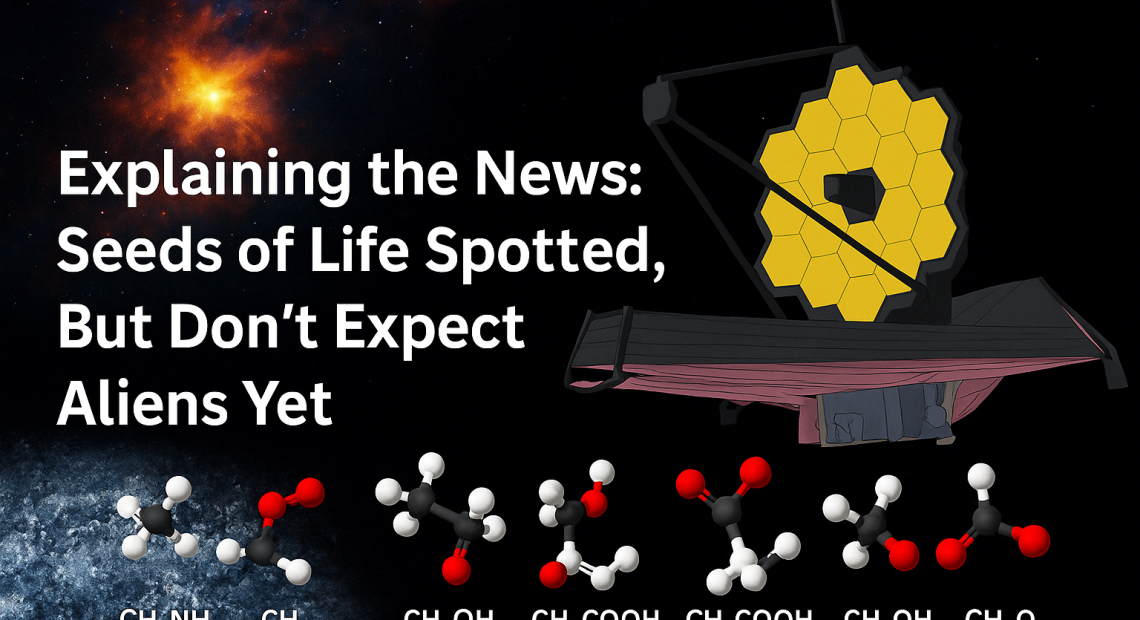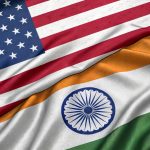
Explaining the News: Seeds of Life Spotted, But Don’t Expect Aliens Yet
The James Webb Space Telescope has once again widened humanity’s window on the universe, this time by detecting complex organic molecules in icy dust surrounding a forming star in the Large Magellanic Cloud, a small galaxy orbiting our own Milky Way. These molecules, which include methanol, ethanol, acetic acid and other carbon-rich compounds, are often described as the “seeds of life” because on Earth they played a vital role in the chemistry that led to more complex biomolecules and eventually the emergence of life. The discovery is remarkable not because it confirms the existence of life elsewhere, but because it shows that the building blocks for life’s chemistry can form in places once thought too inhospitable.
The Large Magellanic Cloud is no ordinary laboratory. Unlike the Milky Way, it is relatively poor in what astronomers call “metals,” meaning elements heavier than hydrogen and helium. Such elements are essential for building complex chemistry, and astronomers once believed their scarcity in such galaxies would make life’s raw materials less likely to form. On top of this, the LMC is bathed in high-energy ultraviolet radiation, which can destroy fragile molecules before they have a chance to combine into anything useful. Yet despite these challenges, Webb’s sensitive instruments picked up clear signatures of organic molecules locked in icy mantles coating dust grains around a very young star.
This matters because it pushes the conversation about life’s chemistry out of our local neighborhood. Within our Solar System, scientists have already detected organics on comets, in the plumes of Saturn’s moon Enceladus, in the haze of Titan’s atmosphere, and in the rocks of Mars. Within the Milky Way, similar discoveries have been made in interstellar clouds like Sagittarius B2 near the galactic center, where alcohols and even sugar-like molecules have been found. But this is the first time such complexity has been confirmed beyond our galaxy, in an environment that is both chemically and radiatively hostile. The message is clear: the universe seems adept at producing the same molecular ingredients no matter where we look.
Still, one must be careful not to confuse ingredients with outcomes. Detecting ethanol or acetaldehyde in an icy star-forming cloud is not the same as finding microbes swimming in an alien ocean. What Webb has delivered is a snapshot of the cosmic kitchen before the cooking even begins. The protostar at the heart of this discovery is still forming, and planets, if they emerge, are millions of years away. Even once planets form, the evolution of stable environments capable of nurturing life could take billions of years. On Earth, it took nearly a billion years after the planet cooled for the first simple organisms to appear, and several more billions before complex multicellular life flourished. Webb’s discovery therefore gives us a glimpse not of alien life, but of chemistry at the very earliest stage of that long road.
That distinction is crucial. Too often, sensational headlines blur the line between finding molecules and finding life. The scientific community is far more cautious. What excites researchers is not the immediate prospect of alien organisms, but the growing body of evidence that the chemistry necessary for life is neither unique nor rare. If methanol and acetic acid can form in the Large Magellanic Cloud under intense radiation and low-metal conditions, then it is reasonable to believe such chemistry was also possible in the early universe, when galaxies everywhere had fewer heavy elements. This broadens the timeline and the geography for when and where life-friendly molecules could arise.
Another reason the discovery matters is that radiation, though often destructive, can also drive chemistry. On Earth, ultraviolet light and other forms of energy helped break apart simple molecules and recombine them into more complex organic compounds. In the LMC, despite the harsh conditions, Webb has shown that this process can still take place. It suggests that the balance between destruction and creation may tilt toward chemistry even in extreme environments. That resilience is encouraging for astrobiologists who argue that life may not need Earth-like comfort zones to get started.
The discovery also dovetails with the way scientists frame the search for life in stages. The first step is to find the ingredients: simple organics, water, and other basic molecules. The second step is to identify potential habitats, planets or moons where these ingredients can be protected and concentrated. The third step is to look for biosignatures, such as unusual gas combinations in exoplanet atmospheres that suggest biological activity. And the final step, perhaps centuries away, would be detecting technosignatures, evidence of intelligent life. Webb’s detection sits firmly at stage one, but it extends that stage into new territory by proving the ingredients can be found not just in our Solar System or galaxy, but across intergalactic space.
Comparisons help put the news in perspective. Within our Solar System, comets and asteroids are rich in organics, and some scientists believe life’s building blocks were delivered to Earth by such bodies. On moons like Enceladus and Europa, organics mingle with subsurface oceans, making them prime candidates for life today. On Titan, methane lakes and a thick atmosphere filled with hydrocarbons create a natural laboratory for exotic chemistry. Beyond, in our galaxy’s star-forming regions, telescopes have repeatedly found the same molecules Webb now sees in the LMC. The consistency across these very different environments hints that organic chemistry is a natural outcome of how the universe works.
For the public, though, the key is to manage expectations. This discovery does not mean there are aliens in the Large Magellanic Cloud waving at us across the void. It means that the raw grocery list for life’s recipe is more widespread than we once dared to think. But groceries do not cook themselves into meals. The journey from methanol frozen on a dust grain to living cells is immense, requiring protective niches, stable environments, and evolutionary leaps that remain mysterious even on Earth. The odds that we are seeing life itself are slim. What we are seeing is the opening act.
It is also worth remembering that we are looking back in time. The Large Magellanic Cloud lies 160,000 light years away, so the molecules Webb observed existed that long ago. Whatever has happened since remains hidden to us. The protostar may have matured, the dust may have collapsed into planets, or the chemistry may have been blasted away. Our telescopes capture snapshots, not live feeds, so any speculation about what exists there now is guesswork.
And yet, the philosophical weight of the discovery is undeniable. Humans have long asked whether life is a cosmic accident or an expected outcome of universal laws. The more places we find these molecules, the more the scales tip toward universality. Webb’s find is one more line of evidence that the universe is stocked with life’s raw materials, waiting for the right circumstances to ignite the spark of biology. That does not guarantee life elsewhere, but it makes the cosmos feel a little less lonely.
In the end, the discovery is a reminder of both our progress and our patience. The James Webb Space Telescope was built to push the boundaries of what we can see, and it is succeeding. But life’s story unfolds across billions of years, and Webb has shown us only the earliest chapter in another galaxy’s potential tale. For scientists, that is more than enough: a sign that chemistry is universal, resilient, and ready to surprise us again. For the rest of us, it is a humbling thought — that the seeds of life may be scattered not just in our own backyard, but across the stars and beyond.


















